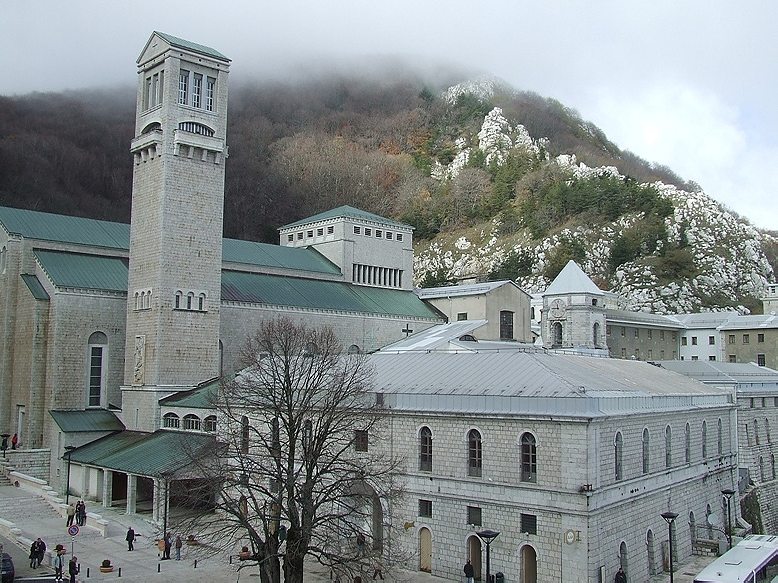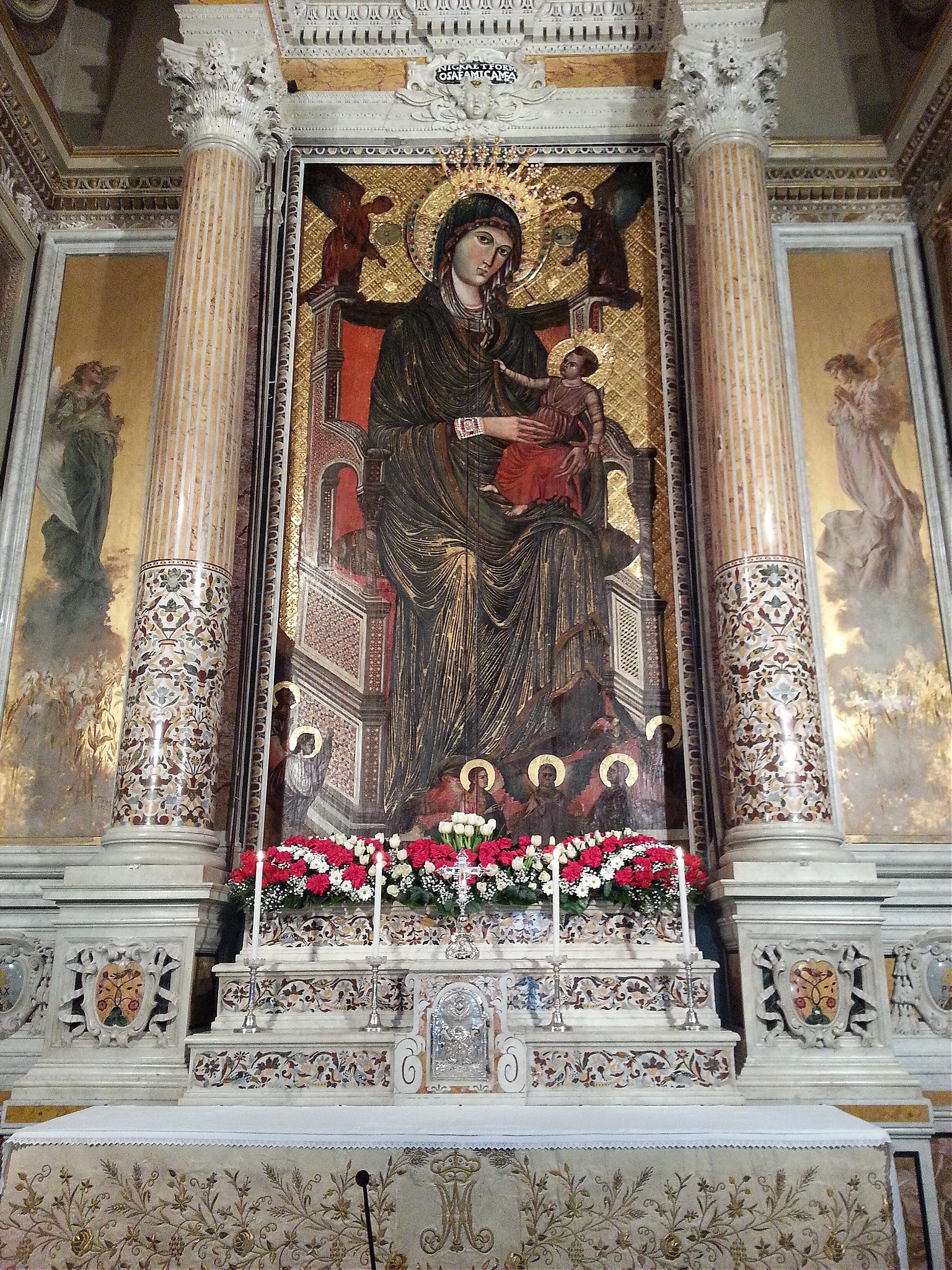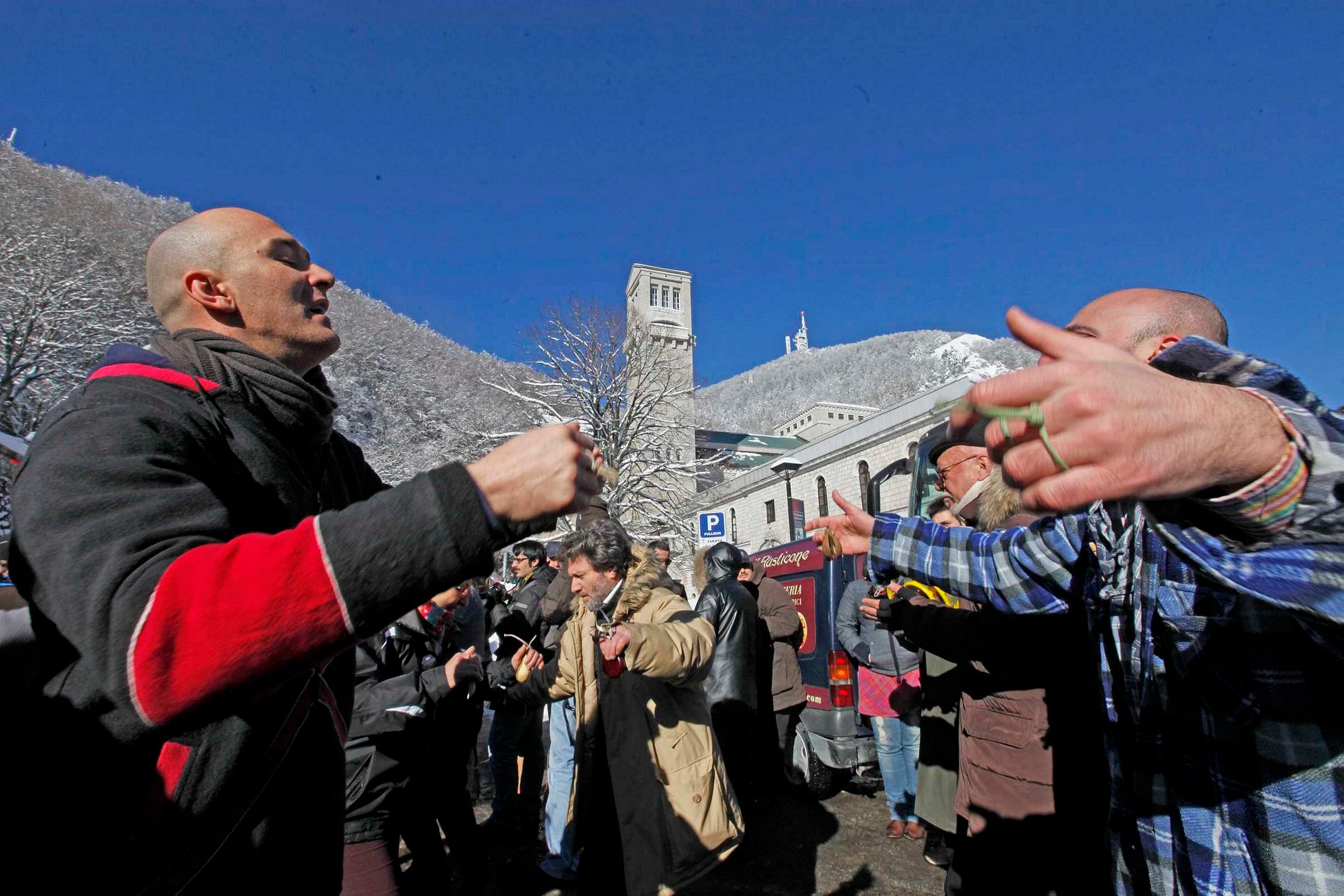In Italy, lesbian, gay, bisexual and transgender pilgrims flock to the Madonna of Transformation.
Irpinia contradicts everything you expect about Southern Italy. The rainy climate and green mountains have more in common with the Pacific Northwest than the Amalfi Coast, just 40 miles away. Instead of Roman ruins like those at Pompeii, stones remain from the Osci, the native Campanian tribe known for their salacious festivals. The spiritual center of the region is the famously hard-to-reach church at Montevergine.
Pilgrims arrive after long bus rides over highways that span seemingly bottomless gorges. Irpinia’s landscape is foreboding, which is why the Montevergine pilgrimage has always required strong and focused devotion. The thin air is hard to breathe. The damp stone from the mountain’s peaks perfume the air with ancient minerals.
In the cleared piazza, old women sell candles and chestnuts, but the attention belongs to the crowds of dancing men and women beating tambourines and clapping out ancient rhythms with castanets. If you took away the down coats and wool hats, the scene would look like it inspired one of the ancient mosaics on display at the archaeological museum in nearby Naples.
Energy builds among the devotees who pray and sing as the faithful have done here since the thirteenth century. But on February 2nd devotees wear lipstick and stubble and feather boas. By the time night descends, over two thousand gay, lesbian, bisexual and transgender pilgrims will have passed through this Catholic shrine to worship the icon they call the ‘Madonna of Transformation.’

Saint William of Vercelli established the first monastery at Montevergine in the twelfth century and is said to have gotten here with the help of a wolf rather than the traditional donkey. In the 1950s, when the current basilica was under construction, work crews brought live animals with them that they would slaughter, butcher and eat because they were so far from fresh food. Folk songs recount how pilgrims from Naples would pack their donkeys and travel in caravans through mountains that were filled with wolves’ caves and eagles’ nests.
Inside the darkened church, a procession of now-reverent revelers shuffle shoulder-to-shoulder toward the icon they call Mamma Schiavona, ‘serving mother,’ passing flames to each other on thin white tapers. A male voice calls out in Neapolitan dialect: “O Maronna, quanno si bella.” The crowd responds in unison, praising her beauty and generosity. They look up toward the Virgin who stares back from a golden background, with the Christ child on her lap. Historically, women would lead this type of chanting, but gender is mutable at Montevergine and has been so for millennia.
Mamma Schiavona is one of Italy’s famous black Madonnas. Her adherents describe her as the one who ‘gives everything, forgives everything.’ Her presence on this site has a long lineage rooted in the ancient mother-earth goddess Cybele, with dark skin symbolic of fertile soil.
Centuries ago, the foundations beneath the church supported a temple of Cybele. Brought to Southern Italy from Anatolia, her cult was absorbed into the Greco-Roman world. Rites of Cybele included long, orgiastic rituals of dancing and drumming that today are recognized in the tammurriata, a dance performed between men and men, women and women, and men and women.

“Dancing and drumming could go on for days. As people who worked the earth, they would have had the physical strength and stamina to keep up with the rituals,” says Allison Scola, an expert on Southern Italian folk dance and music. The tammurriata is built around a few simple steps that charge and release sensual energy. Partners can mix movements and react to each other in the moment. Like the whirling dervishes of Sufism, the tammurriata puts people in a trance and prepares the body for spiritual ecstasy and transformation.
The undercurrent of these rituals has always been fertility. In order to be transformed by mother earth, the priests of Cybele, Galli, would castrate themselves, literally sacrificing their own sex. Galli priests were notorious for their long hair, yellow and pink clothing and sexually provocative dances and ceremonies. It is because of Mamma Schiavona’s ancient ancestry that transgender people consider her a protector.
The words sung by pilgrims in front of the icon at Montevergine explain that she is the ugly sister of seven beauties who hid herself so far away from the rest of the world. Then the drums beat louder as the story flips and Mamma Schiavona becomes the most beautiful of all. Pilgrims leave the sanctuary, still singing, drumming and dancing in the snow, long into the candle-lit night.
In 2002, a group of LGBT pilgrims were thrown out of Montevergine by a priest who became enraged by the sound of their tambourines and castanets. Two weeks later, for the February 2nd Candelora feast, hundreds of LGBT pilgrims and activists returned with Vladimir Luxuria, a former member of parliament and Italy’s most famous transgender person. Candelora at Montevergine was officially established as a day of Femminiello Pride.
Femminiello Pride has an entirely local resonance. Femminielli have been important members of Neapolitan culture since the 1500s, serving as entertainers and prostitutes, but with high social standing. The closest parallel today might be the Thai Kathoei or ‘lady boys,’—biological men who identify as women. Preserving the femmeniello’s place in Neapolitan society is part of a larger reaction in Southern Italy against globalization, which many fear is diluting the culture.

Activists used the 2002 protest to affirm their Christianity and their devotion to an icon which has been distinctly linked to the LGBT community since the Middle Ages. In 1256, Mamma Schiavona rescued a homosexual couple from death. Local folklore says that two men en route to worship her were seen kissing and holding hands. The crowd turned angry, stripped them of their clothes, and tied them to a barren tree where they would either be eaten by wolves or die of frostbite. Mamma Schiavona, moved by the couple’s love for each other, rescued them from their chains and allowed them to live together openly in front of the community as proof of her miracle.
Devotion to Mamma Schiavona is not limited to the LGBT community. Before car travel was common, thousands of pilgrims would travel together on foot. Today, Montevergine receives a steady stream of pilgrims year round. Though the Catholic Church officially recognizes Candelora as the presentation of Christ in the temple and the purification of the Virgin Mary, it can also be seen as a celebration of spring’s miracles lying just beneath the frozen winter ground. Many Italian-Americans have their roots in Irpinia, and churches in central New Jersey and Brooklyn have copies of the icon, which are considered powerful mediums of intercession.
Following the devastating Irpinia earthquake of 1980, new highways have been built and restaurants, vineyards and golf resorts now dot the mountainous landscape. But the region remains a world away. This may be the saving grace of Femminiello Pride at Montevergine. The reason for Mamma Schiavona’s endurance might lie right inside Irpinia’s foundational myth: While the Bay of Naples was formed from the tears of a lovesick siren, Irpinia was founded by a fierce female wolf.
Top image: Ciro de Luca.